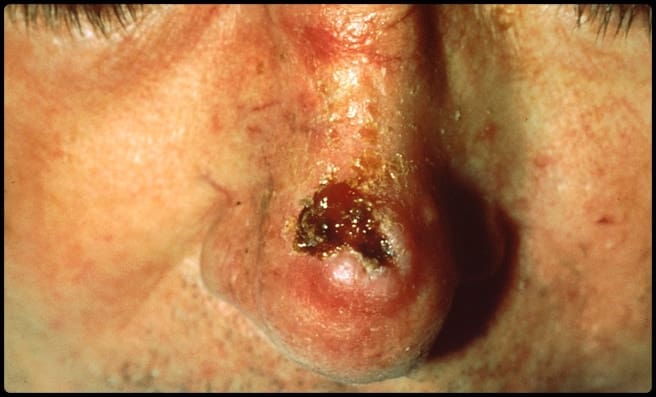Squamous Cell Carcinoma
Similar to Basal Cell Carcinoma, Squamous Cell Carcinomas can be found on areas of the body that are constantly exposed to sunlight; however, they are more often diagnosed on the forehead, scalp, and the backs of the hands. Unlike Basal Cell Carcinoma, Squamous Cell Carcinoma can metastasize to the lungs and lymph nodes.
There are especially aggressive Squamous Cell Carcinomas that can be found in scars, previous burn sites or radiation burns, or chronically inflamed and ulcerated skin.
Arsenic exposure and HPV also increase the risk of getting Squamous Cell Carcinoma. It’s important to remember that for African Americans, this type of tumor can be present in different areas, such as the groin and legs. This type of skin cancer can become very serious, so it’s crucial that you get any red, sore, crust, or scaly patches, bumps, or nodules checked out by a dermatologist.

Related Pages
Quick Quote
How Dangerous is Squamous Cell Carcinoma?
Most SCCs can be easily treated and cured; however, if they are allowed to grow, these lesions can become disfigured, dangerous, and even deadly. SCCs left untreated can become invasive, growing deeper into the layers of the skin and eventually spreading to other parts of your body. The cure rate is very high when compared to other types of skin cancer, but that’s if you get it checked out and treated as soon as it’s detected.
Squamous Cell Carcinoma Symptoms
While SCC of the skin can occur most often on sun-exposed areas, it can appear in areas that you most likely wouldn’t suspect. These can include the inside of your mouth, your genitals, bottoms of your feet, and other similar areas. Some of the symptoms you can look out for include those we’ve listed below.
- Firm, red nodules
- Flat sores with a scaly crust
- An old scar or ulcer that has a new sore or raised area
- Rough, scaly patches on your lips that can become open sores
- Red sores or patches that appear on the insides of your mouth
- Raised, red patches or sores that appear on your genitals
Potential Causes for Squamous Cell Carcinomas
Squamous Cell Carcinomas on the skin occur when the thin, flat squamous cells in the middle and outer layers of the skin develop DNA mutations. The DNA of a cell contains the instructions that tell that cell what job to do, so when a mutation occurs, the cells begin to grow out of control and continue living where normal cells would eventually die.
Most DNA mutations in skin cells are caused by UV (ultraviolet) radiation that is found in sunlight, tanning lamps, and tanning beds. But this exposure doesn’t explain the skin cancer that develops on areas of the skin not ordinarily exposed to sunlight. This indicates that there may be other factors contributing to your skin cancer risk, such as having a condition that breaks down your immune system.
Diagnosing SCCs on the Skin
If you find a place on your skin that is concerning, your doctor may refer you to a dermatologist who specializes in skin conditions such as cancer. They will ask you about your medical history, history or tanning and severe sunburns, pain you may be experiencing, and when the spot or rash first appeared.
You will need to have a physical exam to check for the size, shape, color, and texture of the area. The dermatologists will most likely check for other spots on your body, such as your lymph nodes to ensure they aren’t enlarged or hard. If there is a bump or nodule that looks questionable, they will probably take a skin biopsy and send it to the lab for further testing.
Squamous Cell Carcinoma Treatment Options
Most squamous skin cell cancers are easily found and treated early on, when they are still in a stage where they can be removed and destroyed with simpler treatment options. Smaller squamous cell cancers are more often cured with these treatment options; larger squamous cell cancers can be much harder to treat as they have a higher risk of coming back.
In rare cases, this type of cancer can spread to your lymph nodes or other parts of the body. If this happens, treatment options such as radiation therapy, immunotherapy, and sometimes chemotherapy may be necessary.
Surgery
- Excision – This treatment includes cutting out the tumor, as well as a small margin of the surrounding skin.
- Curettage and Electrodesiccation – This type of treatment option is best suited for smaller cancerous cells, not larger ones.
- Mohs Surgery – Mohs surgery is especially used for SCCs that pose a higher risk for coming back, such as larger tumors, cancers that spread along the nerves, and those that occur on the face and genital area. If all the cancer isn’t removed, this method may be used following the Excision procedure.
- Radiation Therapy – Radiation therapy is a good option for treatment when it comes to patients who have larger size cancers, especially if they’re located in areas such as the eyelids, ears, nose, or other areas that make surgery difficult.
- Cryotherapy – Also known as Cryosurgery, this method is used for early squamous cancer cells, especially for people who can’t have surgery. It’s not recommended for larger, invasive tumors though, or those that are located in areas such as the eyelids, scalp, legs, nose, or ears.
Treating Advanced Squamous Cell Cancers
- Lymph Node Dissection – If your squamous cell carcinomas are large or have grown deeper into the skin, removing any nearby lymph nodes is highly recommended. The lymph nodes will then be examined under a microscope to see if there are any remaining cancerous cells.
- Immunotherapy – If your cancer is advanced and cannot be cured with radiation therapy or surgery, one of the treatment options that can be used is an immunotherapy drug. These medications include Cemiplimab (Libtayo) or Pembrolizumab (Keytruda); however, they have not been studied in patients with weakened immune systems.
- Systemic Chemotherapy or Targeted Therapy – Chemotherapy or targeted therapy drugs, also known as EGFR inhibitors, might be another option for patients whose cancer has spread to their lymph nodes or distant organs. These two treatments can be used separately or combined for advanced results.
What You Can Do at Home
When caught in time, almost every SCC on the skin can be successfully treated and cured; however, if advanced, they can become dangerous. This is why it’s important to keep your eyes open for any symptoms or signs of SCCs.
- Examine Yourself Once a Month – Be sure to keep an eye out for any new or changing lesions that may continue growing, those that bleed, or those that may not heal properly.
- See Your Dermatologist – Always follow your instincts. If you’ve found an unusual place on your skin, seek information from your dermatologist or go in for a check-up.
- Follow Up Regularly – Especially if you’ve already had a Squamous Cell Carcinoma or similar type of skin cancer, you’ll need to have regular visits with your dermatologist.
- Practice Sun Safety – One of the most effective ways to keep yourself safe from getting another SCC or getting it for the first time is to practice sun safety. Wear sunscreen, a large hat, or maybe try wearing pants or a long sleeve shirt if you’ll be outside for an extended period of time.
Why You Should Partner with Winston Salem Dermatology
Despite what most people may think, it’s a crucial part of life to take care of your skin and its overall health. And while it may seem overwhelming to always be checking your skin for lesions or new bumps, it can help keep your skin beautiful and healthy for years to come. Whether you’ve found an unusual place on your skin or if you’d like to learn more about our available products and services, feel free to reach out to us today at +1 (336) 774-8636.
Related Pages
Quick Quote
Address
Winston Salem Dermatology & Surgery Center
1400 Westgate Center Drive,
Suite 200 - Winston Salem, NC 27103
Phone: 336.774.8636
Fax: 336.774.0265
www.WinstonSalemDermatology.com



